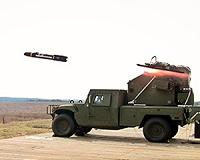| . |  |
. |
Naples, Italy (SPX) Apr 06, 2011 The U.S. Navy, while partnering with joint forces and coalition forces, made several first-time accomplishments During Operation Odyssey Dawn March 31. During the beginning of Odyssey Dawn, strikes were made against Libyan military sites by coalition forces with Tomahawk Land to Air Missiles (TLAMs), the evening of March 19. Amidst the forces were two U.S. Navy ships and three submarines, including the USS Florida (SSGN 728). This strike against Libyan forces marked the first time that an Ohio-class guided-missile submarine launched a TLAM in conflict. "What an accomplishment for the submarine force," said Capt. Mark Davis, commodore, Task Force 69. "This multi-mission platform can remain undetected, yet provide a full range of capabilities to the commander." The following day, U.S. Navy EA-18G Growlers were used against hostile forces for the first time, in conjunction with U.S. Marine Corps AV-8B Harriers, as electronic warfare support jamming enemy transmissions. Later in the operation, U.S. Navy and coalition units came to aid of the Libyan people to engage Libyan Coast Guard vessel Vittoria and two smaller craft who were firing indiscriminately at merchant vessels in the port of Misrata, Libya, March 28. Commander, Task Force (CTF) 65, led by Capt. Dan Shaffer, analyzed their collected data to move appropriate Joint Force Maritime Component Command (JFMCC) forces into position to observe real time events, making this operation the first time that a sea combat commander has coordinated and executed a combined strike against hostile naval forces. Vittoria was engaged and fired upon by a U.S. Navy P-3C Maritime Patrol aircraft with AGM-65 Maverick missiles; the first time that these missiles have ever been fired on a hostile vessel by a P-3C. "P-3s have provided 24/7 ISR maritime domain awareness critical to the protection of U.S. and coalition surface assets in the JOA since the initiation of Odyssey Dawn," said Capt. Dan Schebler, commodore, Commander Task Force 67. "This engagement demonstrates the ability of the P-3 to complete the sensor-to-shooter kill chain, in parallel providing a key capability to the Joint Force Maritime Component Commander and the Composite Warfare Commander." While in pursuit of Vittoria, USS Barry (DDG 52), part of the Kearsarge Expeditionary Strike Group, and coalition naval forces from the French, Italian, Spanish and United Kingdom navies, contributed to the engagement by keeping merchant and humanitarian assistance vessels away from the engagement area and out of harms way. Joint Force Maritime Component Command was the maritime component of Joint Task Force Odyssey Dawn and was commanded by Vice Adm. Harry B. Harris Jr.
Share This Article With Planet Earth
Related Links US Navy Learn about missile defense at SpaceWar.com All about missiles at SpaceWar.com
 Boeing Supports First Hellfire Test Launch From Avenger System
Boeing Supports First Hellfire Test Launch From Avenger SystemHuntsville AL (SPX) Apr 06, 2011 Boeing supported the U.S. Army's first test launch of an AGM-114 Hellfire missile on Feb. 23 at Eglin Air Force Base in Florida. The missile was fired from a modified Avenger weapon system as part of Boeing's continuing development of the Avenger-derived Adaptive Force Protection System (AFPS). "The Avenger turret's ability to launch Hellfire missiles offers the warfighter another choice o ... read more |
|
| The content herein, unless otherwise known to be public domain, are Copyright 1995-2010 - SpaceDaily. AFP and UPI Wire Stories are copyright Agence France-Presse and United Press International. ESA Portal Reports are copyright European Space Agency. All NASA sourced material is public domain. Additional copyrights may apply in whole or part to other bona fide parties. Advertising does not imply endorsement,agreement or approval of any opinions, statements or information provided by SpaceDaily on any Web page published or hosted by SpaceDaily. Privacy Statement |